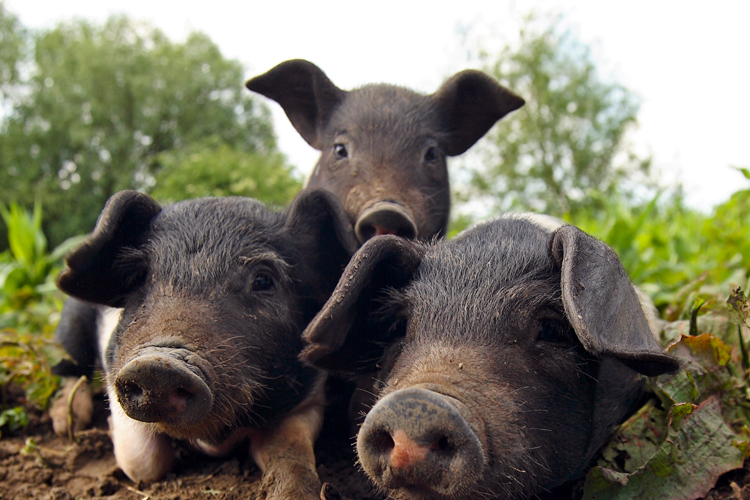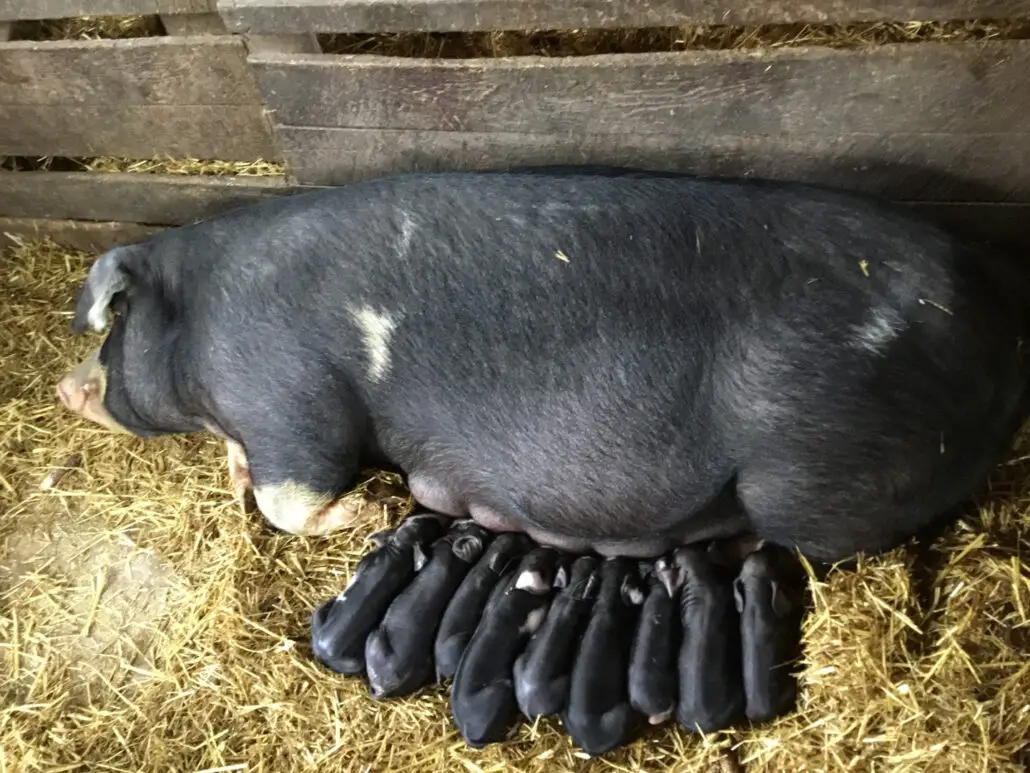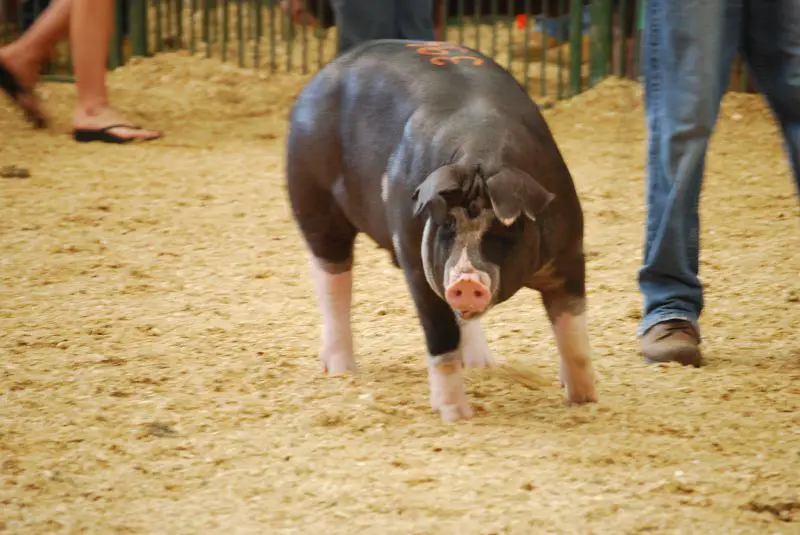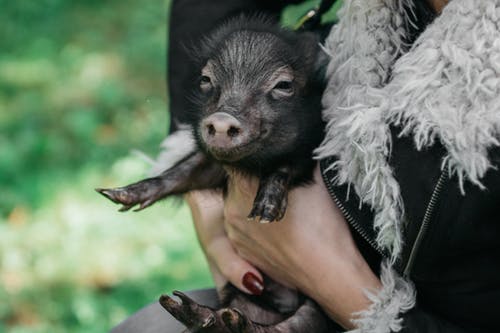Poland China Pigs Pros And Cons – Everything You Need To Know

Since as early as 1816 (reports on the exact date vary) Polish pigs and Big Chinas have been interbred to produce one of the largest and most popular pigs in the Americas.
The Poland China Pig shot to popularity for its sheer size and toughness which allowed them to travel to markets during a time when doing so could sometimes be a huge undertaking.
They are usually recognizable by their size alone, but in order to qualify as purebred, they also need to have a black body, with white feet, a white face, and occasionally one other white splash on the tail, as well as floppy, drooping ears.
Overview table
Size |
Large
Mature weights:Boars: 250 to 370 kg Sows: 226 to 295 kg |
Personality |
Built to conserve energy, they are extremely docile hogs. If they are socialized well though, they are able to become caring companions.
They might not be the most affectionate animals, but they are very easy-going and don’t ask for much. |
Temperament |
As long as they are cared for and have enough space to roam, a Poland China Pig should be happy and docile. |
Tendency to bite |
Very unlikely. If a sow feels her young are in danger she will protect them, and pigs that have not been properly cared for might act out, but generally, they simply wouldn’t see the need to bite a human. |
Dangerous? |
Poland China Pigs are not considered to be dangerous to humans.
That being said, they are extremely large and more than capable of harming people if they aren’t socialized properly and cared for. |
Tendency to root? |
Piglets might root as they are growing up. If they are socialized and trained, however, rooting should not be a problem. |
Maintenance |
2/10
Self-reliance and durability are two of the main reasons for Poland China Pigs’ popularity (along with their size, of course). They really don’t need much. A pig kept as a pet might need a bit more socializing and training than a regular farm pig, but even then, they require minimal maintenance. They are bred to eat and grow and that’s what they do. |
Family pet |
1/5
While these animals can become attached to humans and show recognition and love, they do not make ideal companions simply because they were not bred to be. They can become enormous, which means that they need to conserve energy and are generally less playful than some alternatives. |
Intelligence |
Like most swine, Poland China Pigs are extremely intelligent.
They are able to recognize and remember places and people, especially if it is associated with food, they’re great at solving problems (also, especially when motivated by food) and they can learn to recognize and respond to their own names from a very early age. |
Exercise needs |
Poland China Pigs do not need much exercise. That does not mean they can be kept in small spaces though.
They need a lot of room, even though they might spend the majority of their day eating and sleeping, they still need to be able to roam around and play in the mud as they please. We certainly don’t recommend raising them indoors, which is another reason they might not make the perfect pets. |
Health issues |
Although they are generally extremely robust and durable, Poland China sows have been known to become too large to feed their litters.
Generally, though, they are very resilient, strong-boned and especially easy to raise. One must remember that these pigs were bred to grow fast so that farmers could maximize their profits while minimizing their expenses. |
Life expectancy |
6 – 10 years. While this might be shorter than some other breeds, it, again, goes back to the fact that these pigs were bred to grow to maturity extremely quickly so that they can be slaughtered and their meat sold. |
Price |
Prices will vary depending on the purity of the pigs’ genetics and size.
A large pig with a verified genealogy could fetch well over 1000 USD. The average price for a mature boar is about 400 USD. |

Pros of Poland China Pigs
Purebred Heritage Pig
Strict breeding regulations ensure that you shouldn’t be getting any surprises when purchasing a Poland China with all the correct paperwork.
Bred for the very specific purpose of being sold for meat, a purebred Poland China Pig will be able to grow to be very large without any major health complications.
Intelligent
Like all swine, Poland China Pigs show signs of very high intelligence.
Ranked by some as being in the Top 10 smartest animals, they can be trained just as well as cats and dogs and are highly adaptable.
Calm temperament
Docile and happy by nature, Poland China Pigs have wonderful personalities.
They enjoy playing in the mud and lazing around.
While they may not be as playful as some other pets, they can still be loving and are very unlikely to be aggressive, especially if socialized early.
Large size
Perhaps the most prominent characteristic of this specific breed of pig is its sheer size.
On average they grow to be between 200 and 400 kgs, with extreme examples being much, much heavier still.
This is one of the reasons they are among the most popular breeds among farmers in America, leading the U.S pork production in pounds per pig annually.
Good quality meat
Not only do they grow to be absolutely massive, but they also produce good, lean meat.
This is why the Poland China Pig will always be more of a profitable livestock option than a potential pet.
They played a major role in the development of American livestock farming in the 19th and 20th centuries and continue to do so today.
Low maintenance
Apart from space, a lot of food and a lot of water, the Poland China Pig does not need much.
This is due both to them being extremely docile and remarkably hardy.
These pigs had to survive long, treacherous treks to the markets in the 1800s and so, they are built for survival and do not require much human intervention.
Clean
Contrary to popular opinion, most pigs, including the Poland China Pig are actually extremely clean animals. They are known to designate specific areas as their toilets.
Good for breeding
Yet another reason for their extreme popularity is their prolific breeding habits.
The Utah Pork Producers Association describes them as follows, “Poland boars and sows excel in practical, money-making traits important to profitable pork production — natural soundness, a durable, sturdy structure and the ability to adapt to nearly any environment, from pasture huts to total confinement operations.
Poland sows stay in durable condition, litter after litter, and perform in the farrowing house in a superior fashion.”

Cons of Poland China Pigs
Large size
Yes, that same size that forms a central part of the Poland China Pig’s most appreciated characteristics could also be seen as one of the biggest arguments against them.
Because of their enormity, they require a lot of space and a lot of food and water.
The fact that they can’t be kept indoors or in small yards is also a large part of the reason that they might not make ideal pets.
Expensive
Because of their commercial value, owning a purebred Poland China pig is going to cost you.
Apart from the initial cost, you will then also have to pay for the large quantities of food they need to consume.
This, however, is relative, if you are looking for a Poland China for meat or breeding they aren’t really that expensive simply because they have such a high earning potential.
This is why they are one of the most popular breeds in the world.
Needs Space
Once again, we need to reiterate, Poland China Pigs do not enjoy confined spaces.
They really do need to be on a farm or large plot. It has become a common trend for people to buy piglets, being led to believe that they are miniatures, only to abandon them or put them up for adoption when they suddenly grow to their full size.
Interesting facts About Poland China Pigs
According to Guinness World Records, the largest pig ever recorded was a Poland China that went by the name of Big Bill. This aptly named giant weighed a staggering 1,157kg and stood proud and tall at 1.52 m.
There is also a monument to America’s oldest pedigree pig breed, the Poland China, in Ohio, commemorating the first pedigree of a Poland China hog.
Differences between Poland China and Spot pigs
While the Poland China is one of the oldest breeds, created by crossing Big Chinas with the local polish pigs, its relatively new cousin, the simply named Spot pig, is a cross between Poland Chinas and the local Indiana hogs.
This variation leads to the Spot often looking like an inversion of the Poland China, they have the same droopy ears, but instead of the black body with white tips, Spot pigs are commonly white, with black splashes.
Being so closely related, it seems that their differences might end in their appearances.
Other than that, Spot pigs show much of the same traits and characteristics as the Poland China. Both are excellent breeders and feeders.
Both are large and sturdy. And both make for highly profitable livestock.

Tips for raising Poland China pigs
The amount of socialization and training needed will, of course, heavily depend on whether you plan on keeping the pig as a pet or livestock.
Generally, though, Poland China pigs are resilient and intelligent and do not need much from humans other than a lot of food, a lot of water and ample space.
That being said, because their appetites are so large and these omnivorous munching machines will eat pretty much anything, it is important to make sure that they do not have access to food that may be harmful to them.
The Open Sanctuary has an exhaustive list of food substances that may be toxic to pigs and should be kept away from them.
Conclusion
The Poland China Pig is perhaps one of the best known and loved breeds in the world, certainly in the Americas.
Being bred for a single purpose, and being able to then fulfil that purpose spectacularly, has made this pig a star among livestock farmers and secured its place in the annals of history as the biggest breed of pig known to humankind.
Being low maintenance, intelligent, well-tempered and clean, they might also prove to be great companions, providing you have enough space (that means A LOT of space).
For more than 200 years, the Poland China has proven to be one of the most profitable and desirable breeds in the world, the king of pigs, and it continues its reign to this day.


